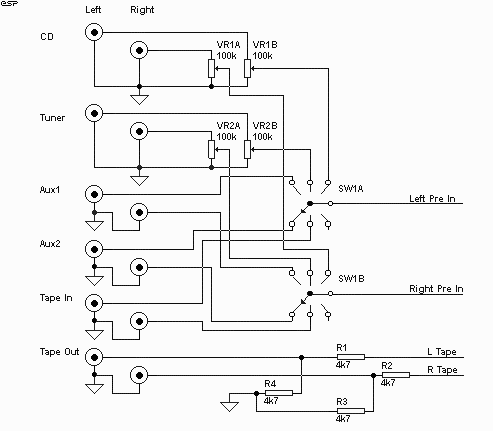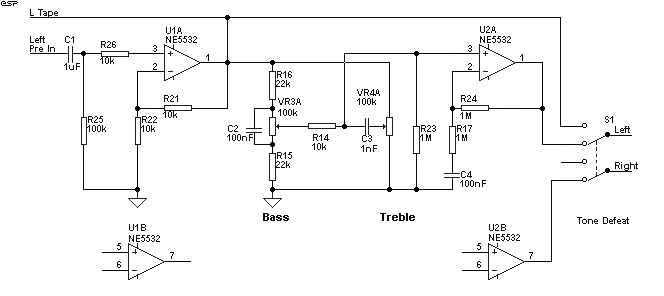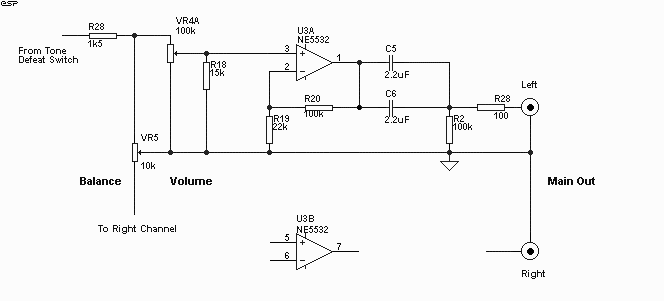Simple High Quality Preamp For Hi-Fi
Introduction
Note: Please see the updated version of the Hi-Fi preamp, shown in Project 88 www.sound.westhost.com. The new version has PCBs available, and is recommended for the best sound quality. If you need tone controls, you should see Project 97 www.sound.westhost.com which has excellent sound quality, and includes tone controls
Much has been made of preamps, but provided a few simple precautions are taken, they are very simple to design, and high performance is almost assured using modern op-amps. For those to whom op-amps are an anathma, please skip this section, AFTER reading the next two paragraphs, please.
While op-amps have something of a bad name in audiophile circles, what must be remembered is that between the music leaving the musician's instrument and arriving at your ears, there is every probability that it has already passed through somewhere between 10 to 100 op-amps - in the mixer (usually more than once), in external effects units, tape machines (analogue or digital), and finally in the CD player itself.
Many of these are not as good as the ones used in this design, and to dismiss a design simply because it uses an op-amp or three is to finish up spending far more than is necessary to obtain the same sonic quality. This is not to say that a good valve preamp (for example) will not sound better (or perhaps just different), but the "op-amp sound" is a myth which should not be perpetuated (and this is from someone who uses a valve and op-amp preamp, both of my own design).
Features
For those who are still with me, the preamp featured has optional tone and balance controls which may be omitted if desired (although I do not recommend this generally). The input switching may be extended if needed to accommodate more signal sources, however in this version, no RIAA (phono) input is provided - see the separate Project Page article for a stand-alone phono preamp which can be added if desired.
The tone controls do not use the traditional "Baxandall" feedback design, but are basic passive controls, which offer a modest 6dB of boost and cut at maximum. This may not sound like much (most tone controls offer 12 to 20dB), but in reality is usually quite sufficient for such minor corrections as are usually needed. (Note that these tone controls can also be used in the Project 88 preamp).
NOTE: The tone controls have been changed slightly from the original publication of this circuit. The treble control should ideally use a 1nF capacitor (10nF was used previously). As now shown, there will be 3dB of boost or cut at 6kHz and 55Hz with the controls at maximum. (I did say that they were subtle!) If the effect is too subtle, increasing the value of the bass and treble caps (100nF and 1nF respectively) will lower the frequency, and vice versa. Some people may find that the bass control is better with a 47nF capacitor - this will almost certainly be the case with small loudspeaker systems.
A tape output is provided - this can be left out if not needed, but again I would suggest that it is worthwhile keeping. The following shows the inputs and switching circuitry.

Figure 1. Inputs, Tape Out and Switching
Construction is not overly critical, but care should be taken to ensure that left and right channel wiring is kept separated wherever possible to prevent crosstalk. All input switching should be performed using an extended shaft rotary switch. This allows all inputs to be shielded in their own section, and reduces the amount of shielded cable required. The input level controls for CD and Tuner inputs allows the levels to be balanced, so that with a little experimenation, it should be possible to switch from one input to any other and retain the same volume. Note that the "traditional" tape monitor switch has not been included, since I suspect it is rarely used these days. If needed, it can easily be accommodated.
The "Tape Out" connectors are wired back to the input amp, so would have had a gain of 2 (6dB) without the attenuator. This also provides useful buffering of the input amp from any "nasties" which could occur (shorted signal leads, etc), and prevents variations in signal when the tape is connected.

Figure 2- Input Buffer and Tone Controls
 | Only the left channel is shown in full, the right channel is identical, and uses the "B" halves of the NE5532 op-amps (pinouts are shown for reference). Note that power is connected to the op-amps ...
|







